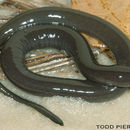Description
provided by AmphibiaWeb articles
The one-toed amphuiuma is an eel-like aquatic salamander. The limbs are extremely tiny and there is only a single toe on each (Neill 1964). As with other members of the family Amphiumidae, there is a single gill slit, no external gills, and the eyes are lidless (Petranka 1998). The dorsum and venter are dark grayish or grayish brown and the venter is only slightly lighter than the dorsum (Means 1992; Petranka 1998). The head is conical and the snout is rounded (Means 1992). This species is considerably smaller than the other two species of Amphiuma. Adults reach 22-33 cm total length (Petranka 1998). The tail is about 25% of the total length. Larvae have branched gills which are resorbed quickly after hatching in the lab; larvae have not been found in the wild (Means 1992).The three species of Amphiuma are similar but can be differentiated based on the number of toes (one, two, or three), coloration, and body size.Because of its small size relative to other amphiumas and reduced number of toes, A. pholeter is considered a dwarf species (Neill 1964; Conant and Collins 1991). Amphiuma means and A. tridactylum are genetically similar, while A. pholeter is quite distinct and likely represents an ancient evolutionary lineage (Karlin and Means 1994).
- Means, D. B. (1992). "One-toed Amphiuma." Rare and Endangered Biota of Florida. Volume 3. Amphibians and Reptiles. Moler, P. E., eds., University Press of Florida, Gainsville, FL., 34-38.
- Moler, P. E. (ed.) (1992). Rare and Endangered Biota of Florida. Volume 3. Amphibians and Reptiles. University Press of Florida
- Neill, W. T. (1964). "A new species of salamander, Genus Amphiuma, from Florida." Herpetologica, 20, 62-66.
- author
- Meredith J. Mahoney
Distribution and Habitat
provided by AmphibiaWeb articles
The one-toed amphiuma has a restricted range in extreme southwestern Georgia, the Florida panhandle, northwestern peninsular Florida (Gulf Hammock region), and coastal Alabama. Populations are patchy in distribution and most occur in Florida (Means 1992; Petranka 1998). Populations occur in small ponds, creeks, and intermittent streams. Individuals prefer to occupy the thick, organic muck at the bottom of these water bodies, a factor that may be responsible for the relatively recent discovery of this species and the difficulty in finding populations (Neill 1964; Means 1992).
- author
- Meredith J. Mahoney
Life History, Abundance, Activity, and Special Behaviors
provided by AmphibiaWeb articles
The biology of A. pholeter is poorly known. Some features are likely similar to other species of Amphiuma (Petranka 1998). Egg laying probably takes place in the summer (June and July). The female coils around the egg mass and hatching occurs in the late summer/early fall (Means 1992).Diet consists of mud-dwelling invertebrates, including earthworms, sphaeriid clams, arthropod larvae, and beetles. Possible predators include racoons, feral pigs, mud snakes (Farancia), snapping turtles, and two-toed amphiumas. Although they tend to keep to the thick bottom-layer of muck, one-toed amphiumas must come to the surface to breathe. During dry periods and droughts, one-toed amphiumas will stay in burrows at least 12 inches underground (Means 1992).
- author
- Meredith J. Mahoney
Life History, Abundance, Activity, and Special Behaviors
provided by AmphibiaWeb articles
Classified as Rare in Florida due to the restricted geographic range, small number of known populations, and unusual habitat type (Means 1992). The Rare status implies that populations not currently endangered or threatened are at risk due to restricted ranges or patchy distribution, both of which apply to A. pholeter (Moler 1992). The wetland habitat of one-toed amphiumas is at risk due to development and agriculture (Means 1992).
- author
- Meredith J. Mahoney
Amphiuma pholeter
provided by wikipedia EN
The one-toed amphiuma (Amphiuma pholeter) is an aquatic, eel-like salamander native to the southeastern United States. It was unknown to science until 1950, when it was collected by herpetologist W. T. Neill. It is rarely observed in the wild, and much about the species remains uncertain.
Description
The one-toed amphiuma is considered aquatic, and ranges in coloration from gray-black to purplish-brown. Unlike the other two Amphiuma species which have distinctively lighter undersides, one-toed amphiumas are the same color on both the dorsum (back) and the venter (belly). It can also be distinguished by its cone-shaped head and toe number—one-toed amphiumas have one toe on each foot as opposed to the two or three exhibited by other Amphiuma species. It is the smallest species in the genus Amphiuma with the average adult size being 8.5 inches (220 mm).
Distribution
One-toed amphiumas are generally known only to occur in parts of the Florida panhandle, extreme southern Georgia, and southern Alabama.
Behavior
One-toed amphiumas are active mostly at night, when they forage for invertebrate prey. Their habits are similar to that of the other members of its genus, preferring slow moving or stagnant, shallow water with either muddy bottoms or areas with weedy vegetation. They have a special affinity for the semi-fluid mud deposits that accumulate in the swampy floodplains of rivers and streams or along the edges of coastal spring-fed rivers. Like all amphiumas, one-toed amphiumas eat small, aquatic invertebrates such as crayfish, annelid worms, insect larvae, and occasionally fish or amphibian larvae. Its breeding habits are largely unknown and eggs and hatchlings have never been observed.[2]
References
- Mount, Robert H. 1975. The Reptiles and Amphibians of Alabama. The University of Alabama Press: Tuscaloosa, Alabama.
- National Audubon Society Field Guide to Reptiles and Amphibians

- license
- cc-by-sa-3.0
- copyright
- Wikipedia authors and editors
Amphiuma pholeter: Brief Summary
provided by wikipedia EN
The one-toed amphiuma (Amphiuma pholeter) is an aquatic, eel-like salamander native to the southeastern United States. It was unknown to science until 1950, when it was collected by herpetologist W. T. Neill. It is rarely observed in the wild, and much about the species remains uncertain.
- license
- cc-by-sa-3.0
- copyright
- Wikipedia authors and editors

